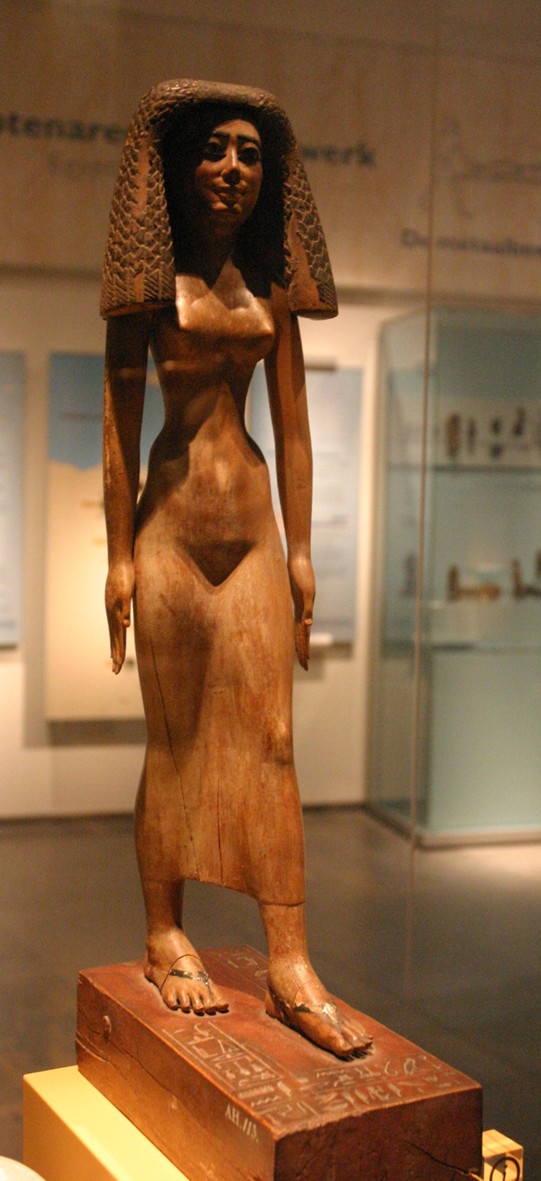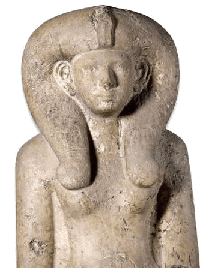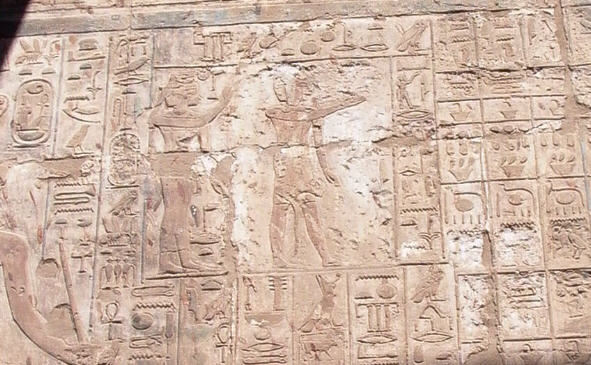|
Maat-ka-Ra Hatshepsut |
last update: 31.05.2008 |
History of the God's Wife in the 18. Dynasty
|
|
||
| God's Wife of Amun (Hmt nTr [n Jmn]) |
Divine Adoratrice (DwAt-nTr) |
God's Hand of Amun (Drt nTr) |
|
Sander-Hansen presented 1940 a history of the institution of the "God's
Wife of Amun" and divided the history into two periods (1st period: 18. Dynasty up to the introduction of the title of the
"Divine Adoratrice of Amun" ("DwAt-nTr nt Jmn")
in the 20. Dynasty, 2. Period: all later God's Wives).
Later in 1981 Graefe submitted another "Investigation regarding the Administration and History of the Institution of the "God's Wife of Amun" from the beginning of the New Kingdom up to the late period" which considers all newer knowledge gained since Sander Hansen. On the basis of the new material Graefe divided the history of the institution of the "God's wives of Amun" into totally 4 periods. However, both publications do not supply any information over the time before the 18. Dynasty. |
 |
According to the LÄ (Vol. II, 802) already two "God's Wife" had existed before the 18. Dynasty. According to this an "Imertnebes" and a "Neferu" had carried corresponding titles. Imertnebes (= Jj-mrt-nb.s; depicted left on a wooden statue D127; origin unknown, today on show at Leiden, Netherlands, according to Porter&Moss VIII.1 the statue possibly came from Thebes of the MK -12. Dynasty ?) is ascribed both titles "God's Hand of Amun and God's wife of Amun"). Neferu (= Nofru) should also have carried this title (according to Newbarry, 1901). However, for dynasties 11 to 14 Troy (1986) lists several women called Neferu (I. - VI.) but according to Troy none of them held the title of a "God's wife". Thus, the title "God's wife of Amun" may probably have already existed for a long time before the 18. Dynasty, and probably, the title reflect the very old idea of the divine origin of the king. This idea that is testified since the 4. Dynasty expresses in the royal title "Son of Ra (Sa Ra)" that God (in the Old Kingdom Ra, in the New Kingdom Amun) in the guise of the reigning king produces together with the "God's and King's Wife" the - divine - heir and successor to the throne. At the same time the "God's Wife of Amun" - as a the "King's Wife" of the current ruler - slips into the human role of Mut the wife of Amun in the realm of the gods. Therefore, here are clear connections to be drawn to the Myth of Birth of the Egyptian kings. |
 |
Left: Ah-hotep
Right: Ahmose-Nefertari |
 |
| During the transitional period from the 17. to the 18. Dynasty,
both, Sander-Hansen (1940) and
Troy (1986), mention Ah-hotep I (see left statue above, from western
Thebes, today at Paris) as first woman who held the title "Hmt nTr n Jmn".
Ah-hotep I is the daughter of Senachtenre and Teti-Scheri, the wife of Seqenenre
Tao,
the mother of Ah-mose, of Ah-mose-Nefertari (see right statue above, today
on show in the Louvre) and further daughters, and the grandmother Amen-hotep I.. The listing of Ah-hotep I. among the "God's Wife" is not completely undisputed. While Sander-Hansen points out that for Ah-hotep I the title is only testified posthumous from the times of Thutmosis I, Troy mentions already three references: stela of a man from Edfu (CG 34009; Urk. IV, 29ff), a scene in the (Ramessid) tomb of Amenemopet (TT A18) who is depicted libating to Amenhotep I. and Ahhotep, and a set of 4 coffins with reference to the cult of Ahhotep, Ahmose-Nefertari, and Amenhotep I, Deir el-Bahari, priest´s cachette (Cairo 6137-8, 6156-7). Nevertheless, some authors still exclude her from the list of the "God's Wife". |
| Depending on the fact whether the respective author accepts the references for Ah-hotep I or not her daughter, Ah-mose-Nefertari, is usually listed as the 1. or 2. woman who had held this title. She has been the wife Ah-mose, the mother of king Amenhotep I and some daughters (Sat Amun, Merit Amun I (= Ah-mose-Merit-Amun I) and, perhaps, of Sat Kamose who likewise all had held the office). |
| However, it is also possibly that this sequence is completely wrong. In 1997 Vandersleyen published a stela which is in the possession of the Kestner Museum, Hannover (quoted after Graefe, 1981). The stela shows king Ah-mose who offers bread in front of Amun-Ra and behind him the "King's Daughter and God's Wife" Sat-Amun. The stela is dated into the regnal year 18 of Ah-mose. After a detailed discussion Vandersleyen has drawn the conclusion that Sat-Amun could not have been the eldest daughter of Ah-mose-Nefertari but rather a daughter of king Kamose - that would move her up in the row of the "God's Wife of Amun" to a position beside or even before Ah-mose-Nefertari . |
 |
The following three "God's Wife" were Sat-Amun, Merit-Amun
I and Sat-Kamose. On the left the upper section of a statue which was discovered by Belzoni at Karnak temple in the proximity of the 8. Pylon. The statue was broken into two pieces, the lower part is still at Karnak in front of the 8. Pylon next to a statue of Hatshepsut which has been reassigned to Amen-hotep I by Thutmosis III, the upper part is today in the British Museum, London. In 1970 it was discovered that both pieces belong together. According to the BM the inscriptions on the lower part mention both, the name of Merit-Amun I and that of her sister, Sat-Amun. However, the inscriptions were destroyed in the Amarna period and are hardly to decipher. Possibly this statue may also depict the mother of Amenhotep I, Ahmose-Nefertari. Merit Amun I and Sat-Kamose were also married with their brother, king Amen-hotep I. The fact that there is no reference that Sat-Amun had also been married to Amen-hotep I could indicate that she died before she got married or that she - see Vandersleyen - was not the eldest daughter of Ah-mose-Nefertari and, thus, has to be put into a former generation. |
Including Ah-hotep I all "God's wives" of the early 18. Dynasty, Ah-mose-Nefertari, Sat-Amun, Merit-Amun I and Sat-Kamose, were descendants of the Ahmosid family and have held - with exception of Sat-Kamose - beside the title of "God's Wife" also the titles of a "King's Daughter" ("sat nesu") and a "King's Sister" ("senet nesu"). There is no reference that Sat-Kamose has held the title of a "King's Sister". |
Obviously, during the reign of the Ahmosid kings the office of the "God's Wife" was reserved for their daughters and sisters. The oldest daughter of the king - if there was none, also his highest-ranking sister - was introduced into the office already in the time of her mother, the acting "God's wife", and concurrently, she was destined to become in future the "Great King's Wife" of her brother or half-brother. By their marriage with their brother or half-brother they secured for their husbands the required legitimation as the new ruler. Thus, Grimm and Schoske (1999) interpreted the institution of the "God's Wife of Amun" as a kind of an addition of the divine legitimation that most likely should secure for the Ahmosid family the right to provide the successor to the throne. In her thesis Schmitz (1976) had pointed out that at the beginning of the 18. Dynasty the title of the "God's Wife" (Hmt nTr) replaced the older title of the "eldest" daughter of the king "sA.t-njsw.t-wr.t" - which so far had obviously described the "main = eldest" princess (=heiress) who was intended to become queen. However, this old title was re-introduced at the times of Thutmosis IV. and Amenhotep III. Graefe (1981) contradicted decidedly the opinion that the eldest princess was appointed to the office of a "God's Wife" and thereby was designated to become the wife of the next king. He explicitly refers to the fact that the office was inherited (whereby the direct, familiar, line was interrupted very early - after Merit-Amun I - see below). |
|
The first "God's Wife" of the Thutmosid family was Hatshepsut who, according to Troy (1986), held in addition the title of a "God's Hand". However, although she was a "King's Daughter" and a "King's Sister" there are no testified relations to her predecessors in that office. Thus, in the case of Hatshepsut the title of a "God's Wife" cannot have been handed down the matrilinear line because her mother, Ah-mose, did not held the title of a "God's Wife"! Concerning Hatshepsut this compellingly results in the hypothesis that she must have appointed in this office because she had not been the daughter of a "God's Wife". The last living "God's Wife" - Ahmose-Nefertari, who probably was her grandmother, - could have "adopted" Hatshepsut and appointed her in the vacant office of a "God's Wife". |
| As all the preceding "God's Wives" who
had transferred the office to their presumed daughters Hatshepsut also
handed down the office during her lifetime - probably on the occasion of
her accession - to her own daughter Neferu-Ra.
In the opinion of Grimm and Schoske (1999) at the same time Neferu-Ra became the designated wife of the future king, Thutmosis III. |
| For the remaining decades of the 18. Dynasty Sander-Hansen and Troy specify the following "God's Wife": - Isis, wife of Thutmosis II and mother of Thutmosis III, however, the title is only testified on a fragment of a relief from the temple of Thutmosis III at Thebes-West. Probably, Thutmosis III had conferred this title on her posthumous because during her lifetimes she did not held the title. - SatJah (ZAt-JaH), daughter of Ahmose Pen-nechbet and his wife Ipw who had been the nurse of Thutmosis III, SatJah was probably the first wife of Thutmosis III; however, how she got to this title, is just as unclear as in the case of: - Merit-Ra Hatshepsut, wife of Thutmosis III, mother of Amenhotep II, who in addition had held the title of a "God's Hand". According to Graefe (1981) the title of a "God's Wife" cannot have been exclusively handed down the matrilinear line. To support this he refers to Huy, one of the three non-royal "God's Adoratrice" of the 18. Dynasty. Huy calls herself mother of a "God's Wife" but she was neither a "God's Wife" herself nor a sister or an aunt of a king. Her daughter is probably Merit-Ra Hatshepsut. Therefore, Merit-Ra Hatshepsut could have got the title only by "adoption" - e.g. by Hatshepsut, after the death of Neferu-Ra - or her father, the husband of Huy, was a brother of Thutmosis II. |
|
- Merit-Amun II, daughter of Thutmosis III and Merit-Ra Hatshepsut, sister of Amenhotep II, had held both titles that of a "God's Wife" and that of a "God's Hand". Probably, she has taken over the title from her mother. - Tiaa, wife of Amenhotep II and mother of Thutmosis IV, according to Troy she had held the title of a "God's Wife" and according to the LÄ (Vol. VI, 554) also that of a "God's Hand". Tiaa neither held the title of a "King's Daughter" nor that of a "King's Sister", i.e. also she did not get the title over the matrilinear line. - Mutemwia, wife of Thutmosis IV and mother of Amenhotep III,
Sander-Hansen listed her as a "God's Wife", but Troy and Graefe
did not put her on their list. According to the current knowledge the list of the "God's wives" of the 18. Dynasty ends it with Tiaa. After Tiaa the office could have been either handed over to a collateral line of the royal family (which would of course reduce the chance to find any records on appropriate monuments) or for the following time of the dynasty the title was not held anymore by members of the royal family (i.e. there was no more royal owner of the title while the priesthood itself probably was still in use - this is supported by two relief at Luxor temple which show king Amenhotep III accompanied by female priests who are represented as a "God's Wife"). |
| Duties of a God's Wife Quite few is known about the daily religious obligations and duties of a "God's Wife". However, due to the increasing importance of the cult of Amun the title surely was a substantial upvaluation of the queen. Apart from the assumption of cultic obligations the position of the "God's Wife" was obviously also connected with the conveyance of numerous real estates including their administration. Thus, this office might have made it possible for the royal family to apply a certain control of the priests of Amun |
| Concerning the rites we only know some representations.
Obviously at all times the "God's Wife" (likewise
the God's Hand or the Divine Adoratrice) had the important duty
to play the Sistrum in front of the statue of
Amun. Obviously, Ah-mose-Nefertari had somehow became a historical model, because still at
the times of Ramses II and Ramses III she was
represented playing the Sistrum in front of Amun. Based on the representations of
Ah-mose-Nefertari the "God's Wife" - playing the
Sistrum - participated in the daily rites which had to be accomplished by the king. According to Sander-Hansen (1940) the office of the "God's Wife" was probably a rather fictitious priesthood. This is further supported by representations of unknown "God's Wives" at Luxor temple (mentioned above) which show that the rites could also be delegated - since the "God's Wives" depicted here do not show the wife of Amenhotep III, Tiye. In the aforementioned representations at Luxor temple the "God's Wife" do not play the Sistrum, obviously, they are depicted in a quite different "function" - one shows the presentation of minor offerings which are accomplished by the king. |

| Above an unknown "God's Wife" (left; the signs Hmt nTr are to be seen directly between her face and her arm) following a priest (right), both accompany king Amenhotep III (see cartouche on the left side). By the signs Drt nTr in front of her legs the lady is also addressed as a "God's Hand". |
| Residence It is not known whether the "God's Wives" of the 18. Dynasty had their own official residence and if, where this has been. Later on Herodot (quoted after Sander- Hansen, p 31) mentioned a room or a chamber in the temple of Amun-Zeus which was reserved for the "Pallacide" of the god. However, the "Pallacide" mentioned by Herodot was rather a member (possibly the chief) of the "Divine Concubines" or the "Divine Harem" (known since the 6. Dynasty) - according to the LÄ (Vol. II., 815) both are to be differentiated from the "God's Wife". Beyond that it is also unknown whether the office required a residence at all for practicing the rites and for the administration of the numerous domains with their fields, storerooms, workshops etc.. |
| According to Sander-Hansen there is no hint concerning an own residence in the temple of Amun at Karnak, especially for the first period of the 18. Dynasty when the "God's Wife" has been a member of the royal family. However, it can be assumed that the rites were performed in the temple of Amun - e.g. Ah-mose-Nefertari has once been called "as being beautiful in the House of the Sistrum" that - with regard to the aforementioned activity of "playing the Sistrum" in front of Amun - indicates that the "House of the Sistrum" has been the place were the rites were performed. On the other hand, the title of Ah-mose-Nefertari "God's Wife in the house of Amun (Hmt nTr m pr Jmn)" does not have to mean that she had her residence there. |
| For the late period, at least after the introduction of the title of a "Divine Adoratrice (DwAt-nTr)" which was probably accompanied by changes in function and administration a residence is known. At that time the name "House of the Divine Adoratrice ("Hwt-dwAt-nTr)" describes both the corporation that performs the rites as well as the "Domain of the Divine Adoratrice". |